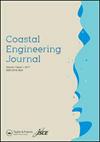非均匀泥沙临界悬浮的新判据
IF 1.9
3区 工程技术
Q3 ENGINEERING, CIVIL
引用次数: 0
摘要
悬移临界条件作为悬移颗粒的下边界,是非均匀输沙理论的重要组成部分,在悬移运动的数值计算中具有重要作用。以往关于临界悬架的研究多基于罗斯数和希尔兹数。本文从最大粒径角度出发,通过水槽试验对非均匀泥沙的临界悬浮进行了研究。根据最大颗粒雷诺数的概念和对实验数据的分析,提出了一种新的非均匀泥沙临界悬浮判据。除非颗粒雷诺数小于或等于与流动和边界条件有关的最大雷诺数,否则沉积物不会悬浮。根据实验数据建立了粒子最大雷诺数与弗劳德数的3次幂和相对粗糙度的1/5次幂成正比的公式。该公式作为一种新的临界悬架判据,合理地描述了悬架初始运动的物理机制。该公式不仅与实验室和现场数据吻合较好,而且与传统准则相比也具有优势。本文章由计算机程序翻译,如有差异,请以英文原文为准。
A new criterion for critical suspension of nonuniform sediment
ABSTRACT As the lower boundary of suspended particles, the critical condition of suspension is an important component in the theory of nonuniform sediment transport and plays a significant role in the numerical computations in the suspended sediment movement. Previous studies on critical suspension are mostly based on Rouse number and Shields number. From the perspective of maximum particle size, this paper conducted research on the critical suspension of nonuniform sediment by flume experiment. A new criterion for critical suspension of nonuniform sediment is proposed according to the concept of maximum particle Reynolds number and analysis of experimental data. Sediments will not be suspended unless the particle Reynolds number is less than or equal to the maximum one related to flow and boundary conditions. A formula, established from experimental data, indicates that the maximum particle Reynolds number is proportional to 3 power of Froude number and 1/5 power of relative roughness. As a new criterion for critical suspension, this formula offers a reasonable description of the physical mechanism for the initial movement of the suspended load. Not only does the proposed formula agree well with laboratory and field data, but it also has its advantages compared with traditional criteria.
求助全文
通过发布文献求助,成功后即可免费获取论文全文。
去求助
来源期刊

Coastal Engineering Journal
工程技术-工程:大洋
CiteScore
4.60
自引率
8.30%
发文量
0
审稿时长
7.5 months
期刊介绍:
Coastal Engineering Journal is a peer-reviewed medium for the publication of research achievements and engineering practices in the fields of coastal, harbor and offshore engineering. The CEJ editors welcome original papers and comprehensive reviews on waves and currents, sediment motion and morphodynamics, as well as on structures and facilities. Reports on conceptual developments and predictive methods of environmental processes are also published. Topics also include hard and soft technologies related to coastal zone development, shore protection, and prevention or mitigation of coastal disasters. The journal is intended to cover not only fundamental studies on analytical models, numerical computation and laboratory experiments, but also results of field measurements and case studies of real projects.
 求助内容:
求助内容: 应助结果提醒方式:
应助结果提醒方式:


